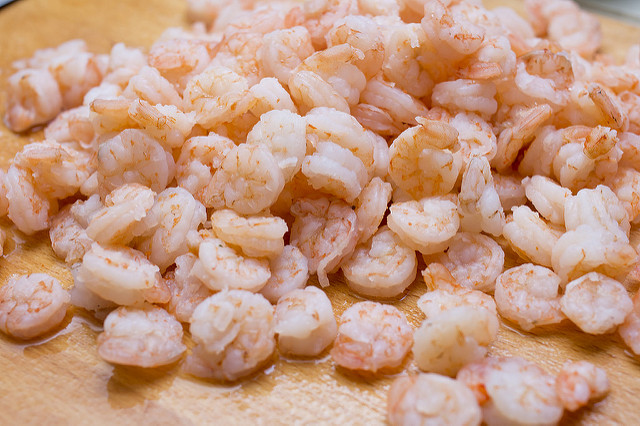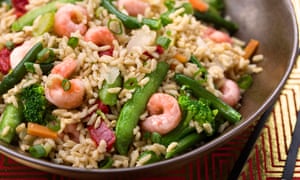http://e-info.org.tw/node/118101
天然「合成蝦」口感堪比真蝦 永續海鮮再邁進一步
文字大小
408 1 Share1
本報2016年9月2日綜合外電報導,姜唯編譯;蔡麗伶審校
蝦是全世界消費量最高的海鮮之一,年產量超過600萬噸,許多國家也對蝦子料理具有狂熱愛好。然而,捕蝦業多年來卻一直擺脫不了環境爭議,因此有生技新創公司利用藻類和植物成份,完全複製出蝦子的外觀和味道,創造出如真蝦口感的合成蝦,預計明年在美國上市。
動物蛋白質替代品與添加物的時代已經到來,全球人類的飲食習慣正逐漸轉型以植物為主,合成蝦正是解決方案之一。圖僅供示意,是真蝦仁。圖片來源:Dennis Amith (CC BY-NC 2.0)
混獲、奴工、紅樹林遭殃 養蝦有害環境
海洋保育出身的「New Wave Foods」執行長巴恩斯(Dominique Barnes)表示,他們已經進行了幾次非正式的盲測,受試者吃不出合成蝦與真蝦的不同。
全球蝦業年產超過600萬噸蝦,而捕蝦業多年來一直具有環境爭議。例如捕蝦船的網子因為網目很小,造成混獲等諸多環境衝擊。而印度、越南、巴西等地的蝦養殖業則造成大片紅樹林和森林被砍伐。此外更傳出震驚產業界的奴工事件——不知情的移民被迫在捕蝦船或養殖場工作,受到殘酷對待無法逃跑,正是這些踐踏人權的事件,讓世界各地有便宜的蝦可吃。
巴恩斯認為,要解決這些問題必須紓緩需求,而合成蝦就是解決方案之一。
不過,海洋保育組織Oceana資深科學家華納(Kimberly Warner)提醒,合成蝦並不能解決全球蝦業的諸多問題,但同時也不斷有資源投入改善蝦業環境:「只要業者做出簡單的改變,美國本土的野生蝦有機會成為安全且永續的選擇,包括提升海鮮來源透明度和改良拖網、減少混獲。」
紅藻自然成色 植物型飲食習慣成全球趨勢
New Wave Foods的合成蝦沒有使用任何動物細胞,紅藻成分讓合成蝦自然呈現珊瑚紅。雖無法分享更多技術細節,巴恩斯表示,原則就是從各種藻類和植物中尋找蝦的基礎成分的替代品。「必須徹底瞭解蝦肉的質感和特性,方能找出可模仿的分子。」
New Wave Foods表示在創投公司的資助下,已完全複製出真蝦的口感和味道。此外,創投公司也將協助他們將產品量產。目前合成蝦已經通過烹飪測試,預計明年在美國上市。巴恩斯說,今年3月New Wave Foods在Google舊金山咖啡館展示合成蝦時,Google執行長當場下訂了200磅。
各種糧食預測皆顯示,動物蛋白質替代品或添加物的時代已經到來。但是對蝦有著狂熱愛好的國家是否會歡迎合成蝦?巴恩斯認為會——即使不為人權、環境,也為了健康。
「全球人們的飲食習慣正逐漸轉型為以植物為主。有什麼比個人的健康更重要?我認為這個好處將能獲得最多的共鳴。」巴恩斯說。
【相關文章】
【參考資料】
ynthetic prawns: a bid to make ‘seafood’ that’s sustainable and slavery-free
A California biotech company receives funding to commercialise algae-based prawns, in an attempt to get people switching to more sustainable diets
How do you describe the taste and texture of a prawn? Sort of rubbery; elastic, even. Like chicken, only better. These unappetising phrases hardly capture what makes it so good—the precise reason why prawns (called shrimp in the United States) are one of the most consumed seafoods globally. But now biotech startupNew Wave Foods is on a mission to mimic the exact texture and taste of a prawn, in a product made entirely out of algae and plant ingredients.
The small, orangey-pink whorls they’ve created look uncannily like the real thing. But what do they taste like? That’s a question for Dominique Barnes, CEO of California-based New Wave Foods. “We’ve done a few blind taste tests—unofficially, you know—and until we tell people it’s made of plants and algae they can’t tell,” says Barnes, who comes from a background in marine conservation.
The company claims to have fully recreated the bouncy texture and fishy undertones of a real prawn: on the back of this success they recently secured seed funding from investors Efficient Capacity and New Crop Capital, which will help get the product off the ground. By next year, they aim to have it commercialised in the U.S.—and already, their imitation prawns have passed the culinary test. When the company presented their product in March at Google’s San Francisco café, the executive chef “was so impressed that he ordered 200 pounds on the spot,” Barnes recalls.
New Wave Foods sprang onto the scene in 2015 with a project aiming to produce artificial shark fin out of genetically modified yeast, in an attempt to make the controversial delicacy more sustainable. Now, the focus has shifted to replicating shellfish. “I grew up in Las Vegas and I had a very bleak perspective on seafood,” says Barnes, describing a place where 99c shrimp cocktails were abundant, despite the city’s location mid-desert, hours from the sea. That’s indicative of America generally, where shrimp can be absurdly attainable, steeped as it is in the country’s culinary culture: it remains the most popular seafood in the United States, with an average four pounds consumed per capita each year. “Shrimp really stood out as this well-loved product, but also one with lots of problems,” says Barnes.
The prawn fishing industry has been at the heart of an environmental controversy for years. Ocean-going vessels are linked with multipleecological ills, including bycatch, thanks to the unforgiving fine mesh nets used to scoop up prawns from the sea. Prawn aquaculture, carried out at industrial scales in countries like India, Vietnam, and Brazil, also results in widespread mangrove destruction and deforestation. Then there’s the industry’s shocking link to slavery: migrants unwittingly trafficked into the industry, typically in Asia, are forced to work on fishing boats and farms, enduring brutal conditions with little hope of escape. It’s this backlog of human rights abuses that make prawns so abundant and affordable in many parts of the world.
“There are many growing concerns associated with imported, farm-raised shrimp, as well as the devastating human trafficking on certain foreign shrimp vessels and farms around the world,” says Kimberly Warner, senior scientist at ocean advocacy non-profit Oceana, who also produced a report in 2014 on the widespread mislabelling of shrimp in the U.S. Barnes, who felt the solutions to these problems “were moving slower than we needed them to,” sees synthetic prawns as a way to take some pressure off the oceans.
The prawns are made completely without animal cells: the recipe blends plant ingredients with red algae, which gives the product its realistic coral hue. While the company can’t share the finer details of their technique—pioneered by the company’s materials scientist and co-founder Michelle Wolf—Barnes says it involves pinpointing the building blocks of the food they’re trying to replicate, and searching for replacements in a wide range of algae and plants. “It’s really about understanding what creates the texture properties of shrimp, and then looking for molecules that mimic that,” she says.
In the lab, they use machines to rigorously test the tensile strength, elasticity, and texture of the synthetic prawn to make sure it comes as close as possible to the real thing. “But really there’s no better tool to measure texture than a mouth,” says Barnes. “So there’s a lot of taste testing!”
Producing over 6 million tonnesannually, the global prawn industry is massive; of course, replacing the real thing with artificial prawns isn’t going to solve the industry’s myriad problems. It’s also important that resources continue to be channelled into improving prawn fisheries and farming in the U.S. and elsewhere, Warner says. “Wild-caught, domestic shrimp has the potential to be a safe and sustainable choice if the U.S. seafood and fishing industries just make a few simple changes,” she says—like improving seafood traceability, and upgrading trawl nets so they snare less bycatch.
Food forecasts indicate in any case that the future is ripe for animal protein analogues, whether as a replacement, or an addition to the real thing. But will a shrimp-obsessed nation be likely to welcome imitation shellfish into their homes?
Barnes thinks so, though not necessarily due to shattering revelations of slavery and the industry’s environmental impact, so much as the product’s health benefits. “Globally, one of the top trends overall is people moving towards plant-based diets,” she says. “What’s more personal than your health, right? I think that benefit of the product will resonate with the most people.”
Next year, the company plans to debut commercially with small breaded prawns, known as the wildly popular ‘popcorn shrimp’ in the U.S. In the future, they hope to bring the product to other parts of the world, too. “Just give people an easy way to make a change, and they’re doing this for themselves and the environment,” says Barnes.



沒有留言:
張貼留言